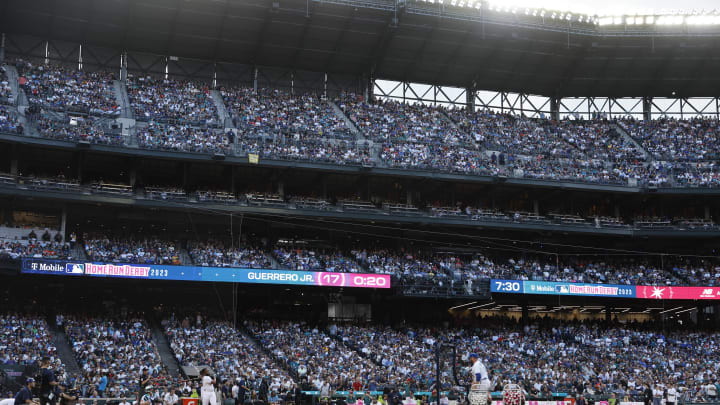Explaining MLB's New Home Run Derby Rules

In an effort to alleviate the sometimes-frenetic pace of the event in past years, MLB has implemented rule changes for the 2024 Home Run Derby.
Here's everything you need to know about the rule changes ahead of the Home Run Derby, which is scheduled to take place on July 15 at Globe Life Field in Arlington, Tex.
New Home Run Derby Rules
Change No. 1: No More Head-to-Head Bracket in First Round
There will no longer be head-to-head brackets and seeds in the first round, as there were in past years. The eight hitters will compete against each other directly and the top four will advance to the semifinal. If there is a tie between hitters after the first round and the ensuing bonus period, it will be broken by whoever hit the longest home run in the first round.
In the semifinal round, the bracket style will pick back up, with 4 vs. 1 and 3 vs. 2 seeded, head-to-head matchups. Seeds will be determined by the total number of home runs each of the top four hitters tallied in the first round. If there is a tie between hitters after the semifinal and final rounds and the ensuing bonus periods, it will be broken by a 60-second swing-off with no stoppage of time or a bonus period, just as in 2023. If there is still a tie after the swing-off, batters will take part in three-swing "swing-offs" until a winner is determined.
The top two hitters in the semifinal round will then face off in the final round.
Change No. 2: Cap on Number of Pitches per Round
MLB is continuing on with the timed format it first implemented back in 2015, with one key change: hitters will now have a maximum amount of pitches they can see per round.
For the first and semifinal rounds, where hitters will still have three minutes, there is a maximum of 40 pitches that hitters can see. Just like with the old rules, hitters will have one 45-second timeout they can use in each of the first and semifinal rounds.
For the final round, hitters will still have two minutes, but there is a maximum of 27 pitches that hitters can see. Just as in years past, hitters will have one 45-second timeout they can use in the final round. The same bonus rules that applied to the first and semifinal rounds apply to the final round. The tiebreaker rule used in the semifinal round—and in 2023—remains the same for the final round.
Rule Change No. 3: No Timer for Bonus Period
Once the time in each round has elapsed, hitters will still have bonus time, as they did in years past, with another key change.
In past years, hitters received 30 seconds of bonus time at the end of each round, with the potential to earn an additional 30 seconds of bonus time if two home runs that equaled or exceeded 440 feet were hit.
With the 2024 rules, there will be no timer for the bonus period. Instead, hitters will have three outs and will continue to hit until three outs—any swing that fails to create a home run—are made. In another twist, any 425-foot home run in the bonus period will earn a fourth out, meaning that, in theory, an unlimited amount of home runs can be hit during the bonus period. This will allow hitters who are trailing to make up ground without attempting to race against the clock.
What has stayed the same with the Home Run Derby rules?
The timed format, which replaced the outs-based system in 2015, will still be used in 2024—with hitters still receiving three minutes in the first and semifinal rounds and two minutes in the final round. There will still be bonus periods in each round and hitters will still have one timeout they can use in each round.
The head-to-head bracket is still a part of the Home Run Derby, but not until the semifinal round. While there was a change to tiebreakers in the first round, the 2023 rules for tiebreakers in the semifinal and final rounds remain the same.
How Are Home Run Derby Hitters Chosen?
MLB chooses hitters for the Home Run Derby through an invitation process, which players can then accept or decline. Generally, as one would expect, MLB chooses from the top power hitters across the league.
So far, Baltimore Orioles shortstop Gunnar Henderson is the only player to announce his intention to compete in the Derby. Los Angeles Dodgers star Shohei Ohtani indicated that he will likely not be participating in the Derby.
Home Run Derby Winners History
Here are the last eight winners of the Home Run Derby since the event changed to a timer-based system in 2015. Note that there was no Derby in 2020, as the event and the MLB All-Star Game were cancelled due to the COVID-19 pandemic.
Year | Winner | Team | Home Runs Hit in Final Round |
|---|---|---|---|
2023 | Vladimir Guerrero Jr. | Blue Jays | 25 |
2022 | Juan Soto | Nationals | 19 |
2021 | Pete Alonso | Mets | 23 |
2019 | Pete Alonso | Mets | 23 |
2018 | Bryce Harper | Nationals | 19 |
2017 | Aaron Judge | Yankees | 11 |
2016 | Giancarlo Stanton | Marlins | 20 |
2015 | Todd Frazier | Reds | 15 |
